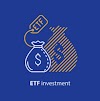ETF or Exchange Traded Fund is a bunch of securities that are traded similarly as of stock. An ETF can be bought and sold multiple times in a day and its price keeps on fluctuating all day. This form of stock is absolutely different from a mutual fund which can be traded once a day after the market closes. For those who are looking to trade Exchange Traded Funds, ETF investment strategies are must to utilize. The strategies help the investor to decide whether they want to establish low cost, bonds & other assets, a well-diversified portfolio of stocks. According to the latest investment survey in Exchange-traded funds, financial advisors recommend investors to invest in this stock.
Is ETF a good investment?
When you are buying an ETF, you are eventually buying a complete collection of different stocks. This is why it is extremely safe r to invest in an ETF rather than investing in an individual stock. There are more likely chances that the stock of one company may go down but stocks of different companies go down simultaneously are practically not possible. Most financial advisors recommend ETF's as unlike mutual funds that are traded at the end of the day, ETF's are traded throughout the day. There are wide chances of gaining profit multiple times by following some of the good ETF industry strategies.
What are the investment strategies of ETF's?
Exchange-traded Funds are good for those who are beginners in the stock exchange market. Investing in an ETF is quite beneficial as they are available at low expense ratios, there are available a vast range of investment options, abundant liquidity, low investment threshold, diversification and so on. Here are some useful ETF investment strategies described for those who are looking to invest in ETF's.
- Dollar-cost averaging: Dollar-cost averaging is an approach for buying an asset that is of a certain fixed amount on a regular schedule, in spite of the changing price of the asset. The investors who are beginners are generally young individuals who have a stable income and can save some amount every month. Thus, investing that income into a low-interest saving account, it is good to invest in an ETF.
- Asset allocation: This strategy for ETF investors helps in allocating a part of the portfolio to different categories of assets such as bonds, commodities, stocks, and cash for the purpose of diversification. The low-investment amount for the beginners helps them in introducing a basic investment strategy depending on their risk tolerance capability.
- Swing trading: These trades look to take benefit of the sizeable swings in stocks. The diversification attribute of the ETF's makes them absolutely suitable for swing trading.
These investment strategies help investors to make a better investment in ETF's.
Read More: Chief Investment Officer Consulting






0 Comments